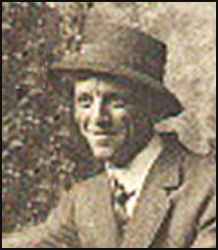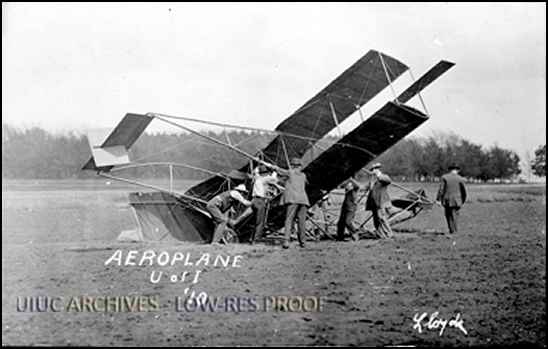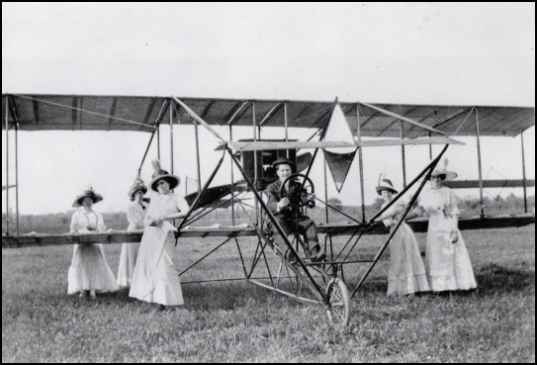
|
|
 |
||
| Otto Brodie - 1910 |
|
via email from Shelley Brodie, 5-27-04 I have some information for you. Firstly I believe he was born in 1888. There is a date given on the pioneer aviators site and I think that's correct. My aunts visited the Smithsonian and retrieved some information regarding him. His son Jim Brodie was a rather famous cowboy in Alberta. Information can be found on Jim Stapleton's The Lone Star Story website. Otto Brodie had 2 sons, Jim and Robert (my grandfather, now deceased). Otto was a jockey in his younger days, and also drove an ambulance. That's how he met his future wife, Blanche Gilfillan, who was a registered nurse at the time. After Otto's death in 1913 she remarried a Danish man, by the name of H.P. Christensen, and settled in Alberta Canada. I hope this helps you out. Sincerely, S. Brodie |
 |
|
University of Illinois Archives |
|
IN TRIAL ASCENSION; NO FLIGHT TONIGHT OTTO BRODIE FALLS WITH AIRSHIP Accident Occurs on University Campus When a Strong Gust of Wind Overturns Craft--Aviator Escapes Injury--Will Fly Sunday The Curtiss aircraft which was scheduled to rise from Scott's pasture in Champaign at 6:30 this evening fell with the aviator, Otto Brodie, during a preliminary flight on the South University campus shortly after 11 o'clock this morning and was badly wrecked. The damaged bi-plane was taken to the University pattern shop and a large force of students and faculty workmen set to the task of making repairs. These will have been completed by Saturday afternoon, and a flight will be given at 4 o'clock that evening as per schedule. One Thousand See Accident
A crowd of 1,000 people saw the bi-plane nearly overturn and fall to the earth from a
height of between forty and fifty feet, and a cry of horror rose from the unsophisticated enthusiasts who
expected the aviator to be killed before their eyes. The board wings, however, afforded sufficient resistance
against the wind to break the fall and Mr. Brodie emerged from the wreck unhurt. The machine alighted on its side
and one wing was crushed like cardboard.Makes Long Flight.
The accident was caused by a strong gust of wind striking the airship as Brodie was
returning from a trial flight of 1,000 feet at a height varying from thirty to fifty feet. The craft seemed to turn
half over in the air and the crowd shouted in terror. Brodie was seen clinging to his levers and working
frantically in an attempt to right the bi-plane, and it appeared that he would be thrown from his seat. His
escape from injury was narrow.Will Make Another Flight.
Brodie will make the flight Saturday evening. He talked to a Courier-Herald reporter
this afternoon and appeared unshaken by his experience during the morning. He would not discuss the accident,
referring the newspaper man to his associate, Mr. Wild, claiming that the latter "is the man who does all the
talking." Brodie is a natural dare-devil and comes by it honestly, for he is a nephew of Steve Brodie, the bridge
jumper who won world-wide fame by leaping from the Brooklyn bridge years ago.Wild is a balloonist recently turned aviator. He was pilot of the balloon "United States" in the recent national race and has won two balloon races. URBANA COURIER-HERALD URBANA ILLINOIS, SATURDAY MORNING, MAY 21, 1915 |
 |
||
|
Otto Brodie - 1910 Supposedly at Love Field in Dallas, 1910 Collection of David Risinger, 7-29-09 |
Early Curtiss - Farman Aviator - Instructor From the Flying Pioneers Biographies of Harold E. Morehouse When Glenn Curtiss won the Gordon Bennett Cup at Rheims, France in August,1909 Plew decided to take the agency for Curtiss planes in Chicago. Later that fall final arrangements were made and Brodie was sent to Hammondsport to learn to fly as his demonstrator salesman. There, with a few verbal instructions from Curtiss, Brodie learned to fly a very early Curtiss pusher biplane with a 4 cylinder 25 H.P. engine, through December, 1909. Charles K. Hamilton was also there practising at the same time. After a short period of practice at Hammondsport Brodie returned to Chicago and a plane was delivered to Plew during the early Spring of 1910. On May 21st to 23rd Brodie and H. Wild attempted to fly an exhibition date at the University of Illinois at Urbana but had their troubles. The field was very muddy and with low power combined with very little flying experience Brodie had a smash up, but fortunately was not injured. A group of manual training students, led by C. R. Sinclair, now an Early Bird, took the damaged plane into the school workshop and made the necessary repairs. A second flight attempt ended in another smash up when he failed to clear some trees on take off. Brodie then shipped the damaged plane back to Chicago. He continued practising at Chicago through the 1910 season and also made a few trial hops in a Montgomery type monoplane that summer for Plew. In February, 1911 Plew sold this early Curtiss plane to James Ward and that month Brodie was one of the founder members of the Franco-American Aviation Company of Chicago. incorporators were Walter R. Sollitt, Otto W. Brodie and Joseph W. Latimer. They purchased a French built Farman Biplane, with 50 H.P. Gnoms engine, from the well known New York sportsman aviator Clifford B. Harmon and started operations using a tent hangar. This plane had an unusual historical significance. It had been brought to the United States by Louis Paulhan for the first Los Angeles Flying Meet in January, 1910 and was used by him at that event, following which he exhibited at San Francisco, Salt Lake City, Denver, New Orleans and at Jamaica, Long Island before returning to France in March. At New York the plane was placed under control of the courts by injunction and was later sold to Harmon, who made several noteworthy flights with it before it was sold to the Franco-American Company. Reportedly it was also the same plane Paulhan had previously used in many outstanding flights in both Great Britain and France during the fall of 1909. The engine was stated to have been formerly owned and used by Claude Grahams-White. Thus Brodie fell heir to a most unusual aeroplane. On April 9th, 1911 Brodie carried Katherine Stinson and Mrs. Charles Coey as passengers, the first women to fly in Chicago. He continued to carry passengers, that month and began booking exhibitions. In June, Brodie was the most active pilot at the new Cicero flying field. On June 30th he had a minor smash up when the engine quit as he was making a banking turn near the ground, but he was not injured. On July 4th he flew in a small local flying meet at Cicero. Also flying were Dan Kramer, Allan Lockheed, Harry Powers and Millie Lenert. Brodie remained very active at Cicero for the 1911 season and carried passengers extensively. On August 24th he flew at Independence, Missouri at a Fair. During this entire period Rudolph W. Schroeder was Brodie's mechanic. In late December Brodie and Harry Powers left to operate a winter flying school at St. Augustine, Florida. There, in addition to the school activities winter resort passengers were carried. Reportedly they also had a Bleriot monoplane there in addition to the Farman. They returned to Cicero in April, 1912 and Brodie flew in the usual season's opening day meet on May 30th. Flying also for this event were Max Lillie, Farnum Fish, Paul Studensky, George Aestach, Lloyd Thompson and Andrew Brew. Brodie remained very active at Cicero during the 1912 season. On June 2nd he flew his pilot license tests at Cicero on his 50 Gnome Farman biplane and on June 19th was granted licence No. 135. In July he conducted the initial flight tests on the new Smith Monoplane, with a 6 cylinder Smith radial engine, and continued to fly this plane occasionally for the balance of the season. He also flew a Curtiss biplane some that summer. During the summer and fall he engaged in exhibition flying at various suburban Chicago areas. Brodie entered and competed in the 1912 Chicago Flying Meet at Cicero in September, and that fall started the Standard Aviation School at Clearing, Illinios, using the grounds formerly used as he Gordon Bennett Race Course, still using the Farman plane. He had a small class which he continued to instruct as late as fall weather permitted. In the spring of 1913 Brodie started school operations again and on April 19th was instantly killed in a crash at Clearing while making a check flight in the Farman before taking up a student. He had made one circuit of the field and was preparing to land when he nosed in from a low altitude. He was badly crushed under the engine which had been torn from it's mounting, killing him instantly. Brodie had planned to give up active flying soon and turn his attention to building planes, and had one of his own design under construction at the time of his death at age 27. He was survived by his wife and two sons. Burial was in Montrose Cemetery, Chicago, Illinois. Flying Pioneer Otto W. Brodie was one of our very first aviators, starting almost at the beginning of that early group who gambled on man's ability to fly. A brother of Steve Brodie of Brooklyn Bridge fame, he gave his life to further the progress of aviation. His name must find it's rightful place in the annals of American aviation history. |
|
|
|
Contributed by Bruce Beveridge, 8-26-09 Here are some snippets from some of my research: Jan 21st 1926 - Plans to develop 247 acres of rough prairie land at Clearing into a modern airport without delay were announced at Chicago city hall this week. The tract located at 63rd street and Cicero avenue has been leased by the City of Chicago from the board of education for 25 years at an annual rental of $1,500. Work of building hangers, runways, beacon lights and of rolling and marking the field will be begun in a few weeks. Feb 20th 1913 Riverside News - Essanay Film News Company were in Clearing filming Mr. Brodie and his Aeroplane carrying parcel post mail between Clearing and Argo. Pictures to be shown at the Orpheum Theater next Monday Night. Feb 20th 1913 RN - Brodie of Clearing flies his plane with 150 pounds of parcel post mail from Clearing to the field behind the Clearing Land office in Argo and back again - all for the camera. Essanay Film Company. (I'd like to see that film!) |
|
|
|
Origin, Operation, Obscurity and Legacy - 1891 to 1916 |
|
He died alone in his plane, prior to taking someone up with him, on a "test run". The engine
dislodged and broke his neck instantly. I am trying to find out where he's buried but so far no luck. If you have any information on this Early Flier, please contact me. E-mail to Ralph Cooper 

|